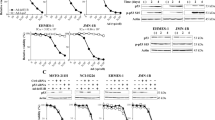Abstract
Pancreatic cancer is one of the intractable diseases and an effective therapeutic strategy is required to improve the prognosis. We examined possible antitumor effects of adenoviruses expressing melanoma differentiation-associated gene-7/interleukin-24 (Ad-mda-7) and a heat-shock protein 90 (Hsp90) inhibitor to human pancreatic carcinoma cells. Ad-mda-7 and an Hsp90 inhibitor, geldanamycin (GA), produced cytotoxic effects, and a combinatory use of Ad-mda-7 and GA further achieved synergistic effects. Administration of N-acetyl-L-cysteine, an inhibitor of reactive oxygen species, eliminated Ad-mda-7- and GA-mediated cytotoxicity. Ad-mda-7 augmented phosphorylated AKT levels but GA did not influence the phosphorylation. GA-treated cells showed cleavage of poly-(ADP-ribose) polymerase but not caspase-3, and upregulated Hsp70 and LC3A/B II levels, whereas Ad-mda-7-treated cells did not. GA treatments augmented ubiquitination and markedly increased melanoma differentiation-associated gene-7 (MDA-7) expression levels. These findings suggest that Ad-mda-7-mediated cytotoxicity is dependent on reactive oxygen species but independent of apoptosis or autophagy, and that GA-mediated cytotoxicity was linked with caspase-independent apoptosis and/or autophagy. A mechanism underlying the combinatory effects of Ad-mda-7 and GA remained complex and the synergism is attributable to multiple factors including increased MDA-7 protein stability by GA.
This is a preview of subscription content, access via your institution
Access options
Subscribe to this journal
Receive 12 print issues and online access
$259.00 per year
only $21.58 per issue
Buy this article
- Purchase on Springer Link
- Instant access to full article PDF
Prices may be subject to local taxes which are calculated during checkout






Similar content being viewed by others
References
Jemal A, Siegel R, Ward E, Murray T, Xu J, Thun MJ . Cancer statistics. CA Cancer J Clin 2007; 57: 43–66.
Sauane M, Gopalkrishnan RV, Sarkar D, Su ZZ, Lebedeva IV, Dent P et al. MDA-7/IL-24: novel cancer growth suppressing and apoptosis inducing cytokine. Cytokine Growth Factor Rev 2003; 14: 35–51.
Caudell EG, Mumm JB, Poindexter N, Ekmekcioglu S, Mhashilkar AM, Yang XH et al. The protein product of the tumor suppressor gene, melanoma differentiation-associated gene 7, exhibits immunostimulatory activity and is designated IL-24. J Immunol 2002; 168: 6041–6046.
Emdad L, Lebedeva IV, Su ZZ, Gupta P, Sauane M, Dash R et al. Historical perspective and recent insights into our understanding of the molecular and biochemical basis of the antitumor properties of mda-7/IL-24. Cancer Biol Ther 2009; 8: 391–400.
Fisher PB . Is mda-7/IL-24 a ‘magic bullet’ for cancer. Cancer Res 2005; 65: 10128–10138.
Dent P, Yacoub A, Hamed HA, Park MA, Dash R, Bhutia SK et al. MDA-7/IL-24 as a cancer therapeutic: from bench to bedside. Anticancer Drugs 2010; 21: 725–731.
Wang M, Tan Z, Zhang R, Kotenko SV, Liang P . Interleukin 24 (MDA-7/MOB-5) signals through two heterodimeric receptors, IL-22R1/IL-20R2 and IL-20R1/IL-20R2. J Biol Chem 2002; 277: 7341–7347.
Su Z, Lebedeva IV, Gopalkrishnan RV, Goldstein NI, Stein CA, Reed JC et al. A combinatorial approach for selectively inducing programmed cell death in human pancreatic cancer cells. Proc Natl Acad Sci USA 2001; 98: 10332–10337.
Lebedeva IV, Su ZZ, Sarkar D, Gopalkrishnan RV, Waxman S, Yacoub A et al. Induction of reactive oxygen species renders mutant and wild-type K-ras pancreatic carcinoma cells susceptible to Ad.mda-7-induced apoptosis. Oncogene 2005; 24: 585–596.
Neckers L, Workman P . Hsp90 molecular chaperone inhibitors: are we there yet. Clin Cancer Res 2012; 18: 64–76.
Blagosklonny MV . Hsp-90-associated oncoproteins: multiple targets of geldanamycin and its analogs. Leukemia 2002; 16: 455–462.
Chada S, Bocangel D, Ramesh R, Grimm EA, Mumm JB, Mhashilkar AM et al. Mda7/IL24 kills pancreatic cancer cells by inhibition of the Wnt/PI3K signaling pathways: identification of IL-20 receptor mediated bystander activity against pancreatic cancer. Mol Ther 2005; 11: 724–733.
Mimnaugh EG, Xu W, Vos M, Yuan X, Isaacs JS, Bisht KS et al. Simultaneous inhibition of hsp 90 and the proteasome promotes protein ubiquitination, causes endoplasmic reticulum-derived cytosolic vacuolization, and enhances antitumor activity. Mol Cancer Ther 2004; 3: 551–566.
Gopalan B, Shanker M, Scott A, Branch CD, Chada S, Ramesh R . MDA-7/IL-24, a novel tumor suppressor/cytokine is ubiquitinated and regulated by the ubiquitin–proteasome system, and inhibition of MDA-7/IL-24 degradation enhances the antitumor activity. Cancer Gene Ther 2008; 15: 1–8.
Guo F, Rocha K, Bali P, Pranpat M, Fiskus W, Boyapalle S et al. Abrogation of heat shock protein 70 induction as a strategy to increase antileukemia activity of heat shock protein 90 inhibitor 17-allylamino-demethoxy geldanamycin. Cancer Res 2005; 65: 10536–10544.
Bhutia SK, Dash R, Das SK, Azab B, Su ZZ, Lee SG et al. Mechanism of autophagy to apoptosis switch triggered in prostate cancer cells by antitumor cytokine melanoma differentiation-associated gene 7/interleukin-24. Cancer Res 2010; 70: 3667–3676.
Pataer A, Bocangel D, Chada S, Roth JA, Hunt KK, Swisher SG . Enhancement of adenoviral MDA-7-mediated cell killing in human lung cancer cells by geldanamycin and its 17-allyl- amino-17-demethoxy analogue. Cancer Gene Ther 2007; 14: 12–18.
Pataer A, Chada S, Roth JA, Hunt KK, Swisher SG . Development of Ad-mda7/IL-24-resistant lung cancer cell lines. Cancer Biol Ther 2008; 7: 103–108.
Park MA, Hamed HA, Mitchell C, Cruickshanks N, Dash R, Allegood J et al. A serotype 5/3 adenovirus expressing MDA-7/IL-24 infects renal carcinoma cells and promotes toxicity of agents that increase ROS and ceramide levels. Mol Pharmacol 2011; 79: 368–380.
Tait SW, Green DR . Caspase-independent cell death: leaving the set without the final cut. Oncogene 2008; 27: 6452–6461.
Acknowledgements
This study was supported by Grants-in-Aid for Scientific Research from the Ministry of Education, Culture, Sports, Science and Technology of Japan, the Grant-in-Aid for Research on seeds for Publicly Essential Drugs and Medical Devices from the Ministry of Health, Labor and Welfare of Japan and a Grant-in-aid from the Nichias Corporation.
Author information
Authors and Affiliations
Corresponding author
Ethics declarations
Competing interests
The authors declare no conflict of interest.
Rights and permissions
About this article
Cite this article
Zhang, Z., Kawamura, K., Jiang, Y. et al. Heat-shock protein 90 inhibitors synergistically enhance melanoma differentiation-associated gene-7-mediated cell killing of human pancreatic carcinoma. Cancer Gene Ther 20, 663–670 (2013). https://doi.org/10.1038/cgt.2013.66
Received:
Accepted:
Published:
Issue Date:
DOI: https://doi.org/10.1038/cgt.2013.66



